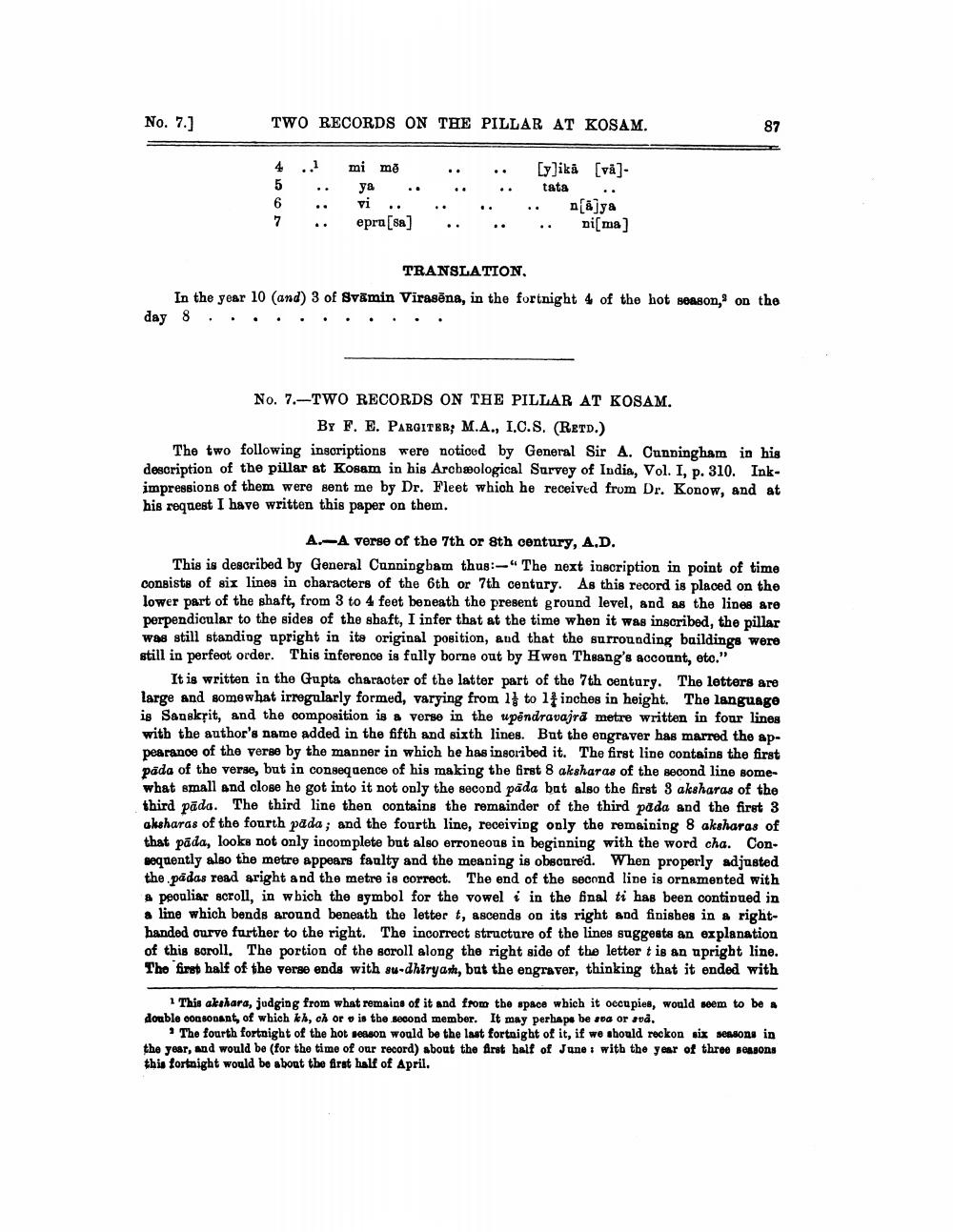________________
No. 7.]
TWO RECORDS ON THE PILLAR AT KOSAM.
4.1
5
6
7
..
mi mě
ya
vi
epra [sa]
[y]ikā [vā]
tata
n[ā]ya ni[ma]
87
TRANSLATION.
In the year 10 (and) 3 of Svämin Virasēna, in the fortnight 4 of the hot season, on the day 8...
No. 7.-TWO RECORDS ON THE PILLAR AT KOSAM.
BY F. E. PARGITER; M.A., I.C.S. (RETD.)
The two following inscriptions were noticed by General Sir A. Cunningham in his description of the pillar at Kosam in his Archeological Survey of India, Vol. I, p. 310. Inkimpressions of them were sent me by Dr. Fleet which he received from Dr. Konow, and at his request I have written this paper on them.
A.-A verse of the 7th or 8th century, A.D.
This is described by General Cunningham thus:-"The next inscription in point of time consists of six lines in characters of the 6th or 7th century. As this record is placed on the lower part of the shaft, from 3 to 4 feet beneath the present ground level, and as the lines are perpendicular to the sides of the shaft, I infer that at the time when it was inscribed, the pillar was still standing upright in its original position, and that the surrounding buildings were still in perfect order. This inference is fully borne out by Hwen Theang's account, etc."
It is written in the Gupta character of the latter part of the 7th century. The letters are large and somewhat irregularly formed, varying from 1 to 14 inches in height. The language is Sanskrit, and the composition is a verse in the upendravajra metre written in four lines with the author's name added in the fifth and sixth lines. But the engraver has marred the appearance of the verse by the manner in which he has inscribed it. The first line contains the first pada of the verse, but in consequence of his making the first 8 aksharas of the second line somewhat small and close he got into it not only the second pada but also the first 3 aksharas of the third pada. The third line then contains the remainder of the third pada and the first 3 aksharas of the fourth pada; and the fourth line, receiving only the remaining 8 aksharas of that pada, looks not only incomplete but also erroneous in beginning with the word cha. Consequently also the metre appears faulty and the meaning is obscured. When properly adjusted the padas read aright and the metre is correct. The end of the second line is ornamented with a peculiar scroll, in which the symbol for the vowel in the final ti has been continued in a line which bends around beneath the letter t, ascends on its right and finishes in a righthanded curve further to the right. The incorrect structure of the lines suggests an explanation of this scroll. The portion of the soroll along the right side of the letter t is an upright line. The first half of the verse ends with su-dhiryam, but the engraver, thinking that it ended with
1 This akshara, judging from what remains of it and from the space which it occupies, would seem to be a double consonant, of which kh, ch or v is the second member. It may perhaps be sua or svå.
The fourth fortnight of the hot season would be the last fortnight of it, if we should reckon six seasons in the year, and would be (for the time of our record) about the first half of June: with the year of three seasons this fortnight would be about the first half of April.




